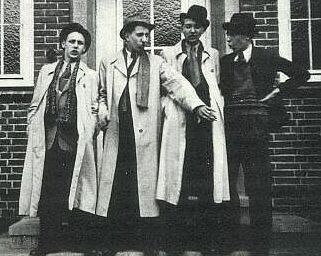
The White Rose resistance efforts demonstrate that, despite the odds, it is possible for a small group of individuals to make a difference. The White Rose was not a disciplined organization; most of their actions reflect spontaneity not meticulous planning. That being said, the White Rose did not wish to develop a vigorously disciplined organization, and "they recognized their inability to physically challenge the regime"(Henderson 45).
The White Rose wanted to spread the voice of Nazi dissent and if they only changed the opinion of one German youth then their efforts were not done in vain. They knew that they alone could not stop the Nazi regime, so the White Rose focused their attention on different aspects of resistance but ones that were still effective. The Nazi regime was “intent on controlling and manipulating public opinion,” (Henderson 45); therefore, through their leaflet campaign, the White Rose intended to halt the penetration of Nazi propaganda into the minds of the German youth.
The White Rose designed a system to ensure that careful measures were being taken to avoid being caught by authorities. However because their efforts targeted German youth, a group the Nazis focused a great deal of time and energy recruiting, they risked being turned over to authorities by their own peers. Regardless of the threats to their lives, the members of the White Rose were determined to counteract the perversions of Nazi propaganda into everyday life.
The leaflets secretly distributed by the White Rose did not simply criticize the actions of the Nazi regime they criticize the apathy of the German people. Moreover, the White Rose chastised the German people for “surrendering man’s most highest principle, that which raises him above all other God’s creatures, his free will,” (First Leaflet). The leaflets called on every individual to rise above apathy and resist the banes of fascism; the German people must resist the totalitarian grasps of Nazism whether actively or passively, they must stand and resist before it is too late.
In the last days of her life, Sophie Scholl reflected on the actions of the White Rose and stated proudly, “thousands will be stirred and awakened by what we have done” (Henderson 44). The White Rose resistance campaign did not culminate in the end of Nazism, but then again this was not their intention. They wanted to force their fellow peers to challenge the blind devotion of Germany to Nazi rule, the impact of which is hard to measure because it is on an individual rather than general basis. Yet one thing is certain, the White Rose provided hope and acted, as a model for those that believed a small number of people could not make a large impact. Their legacy is remembered by their most fundamental principle that people deserve a regime that they are willing to enjoy (First Leaflet).
Further, the leading members of the White Rose were tried and convicted of high treason and attempting to overthrow the regime. The Chief Justice of the Greater German Reich, Roland Freisler, presided over their trial and throughout the court hearings he acted more like the prosecuting attorney than an impartial judge. At the outset of the trial, Freisler called the defendants before him “irredeemable heretics” (Hornberger 1) demonstrating that he had decided their outcome before the hearings even transpired. There were no witnesses called in defense of the accused on account of the fact that the members of the White Rose admitted everything already.
In addition, the White Rose was always aware that if they were caught conspiring against the regime they would be killed; however, this fact was never a deterrent. Therefore, when the members were arrested, the members did not attempt to defend their efforts because to do so would infer they were wrong. Rather then justify their actions the defendants reiterated them and utilized the courtroom as a final forum to voice their dissent. The members of the White Rose were so firm in their convictions that their determination and bravery impressed the prison guards who decided to break the rules and allow the group one last meeting.
The Scholls’ father, while being escorted out of the courtroom was heard shouting, “One day there will be another kind of justice! One day they will go down in history,” (Hornberger 1). Their father’s words rang true and to this day a square stands in the center of the University of Munich honoring the White Rose, its members, and their courageous efforts to resist the tyrannical grasps of the Nazi regime.











